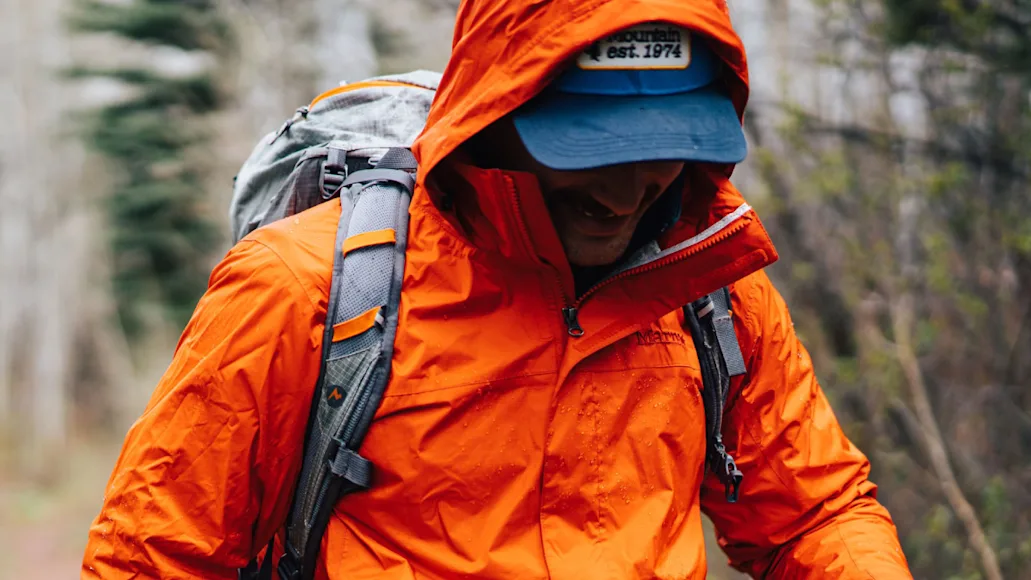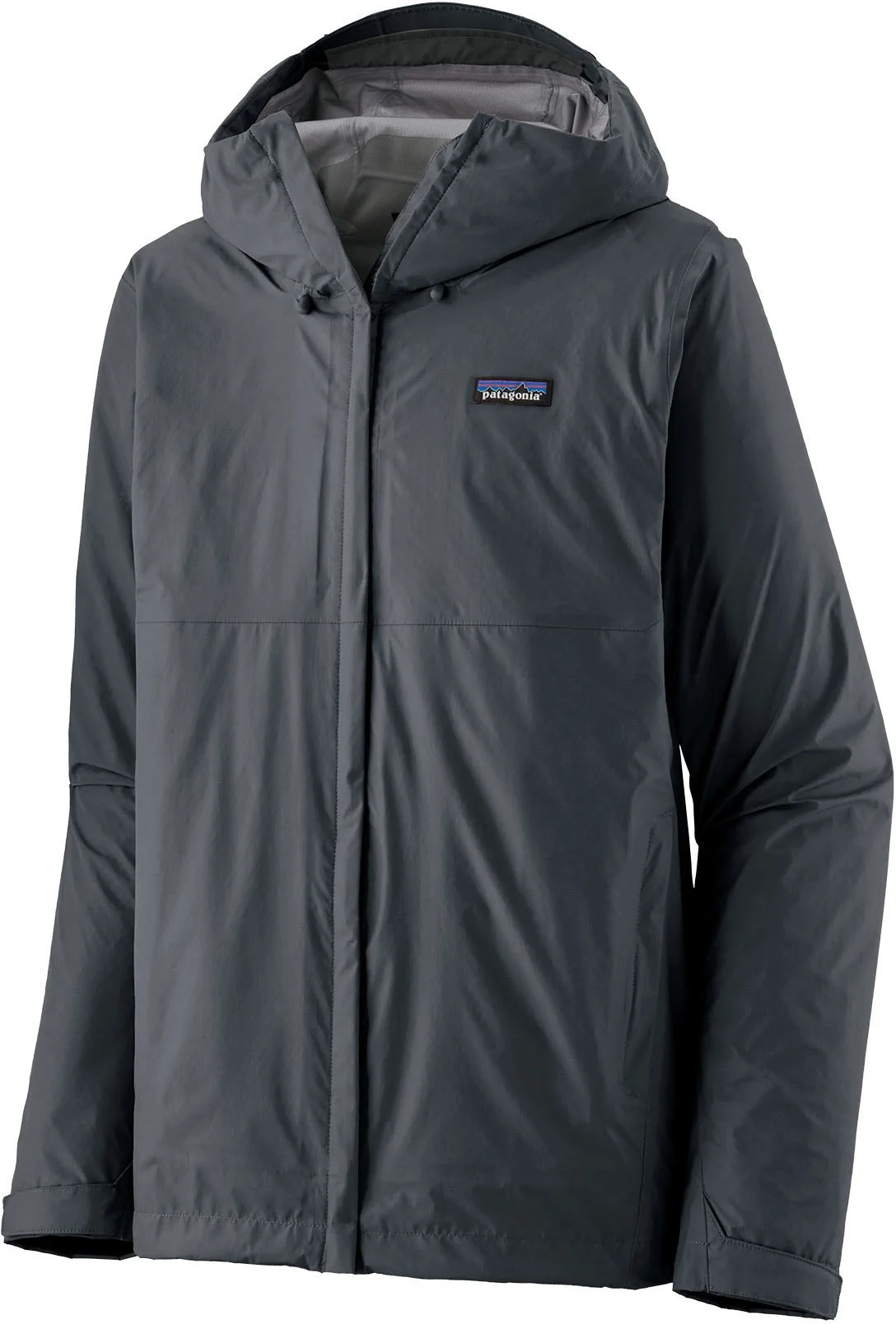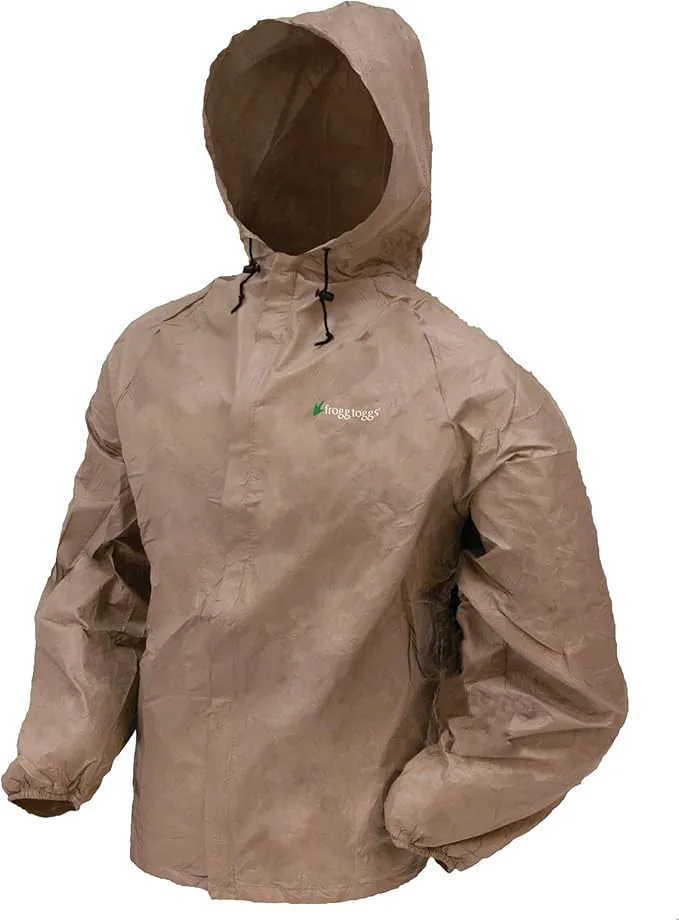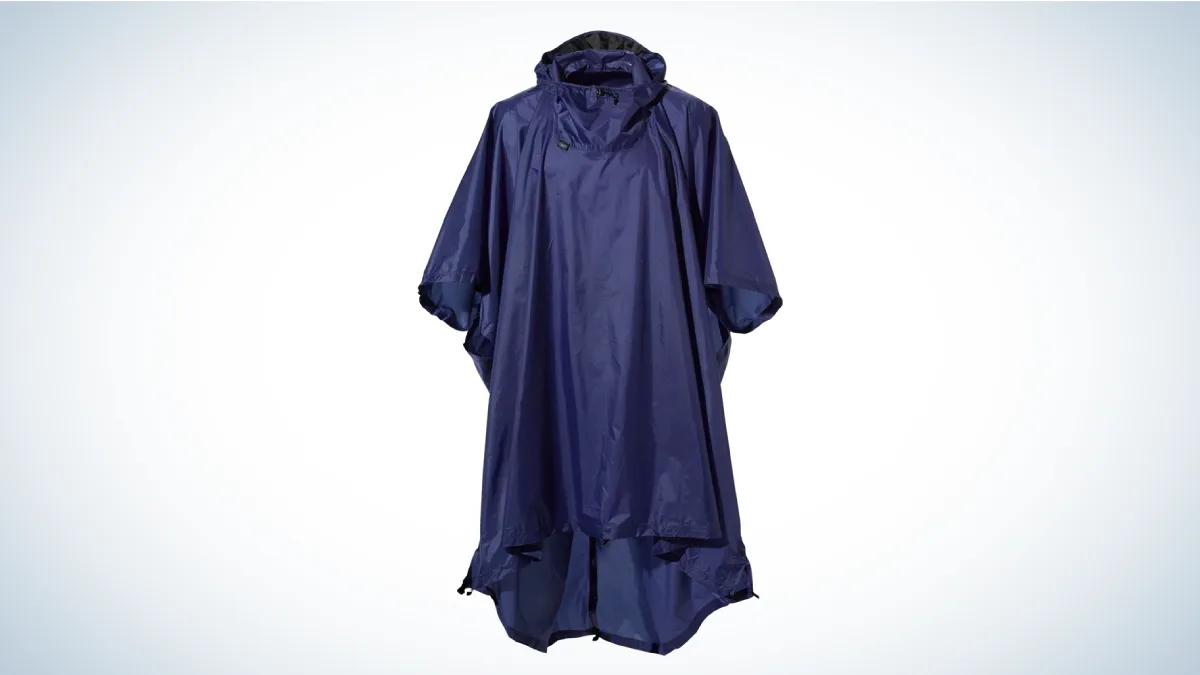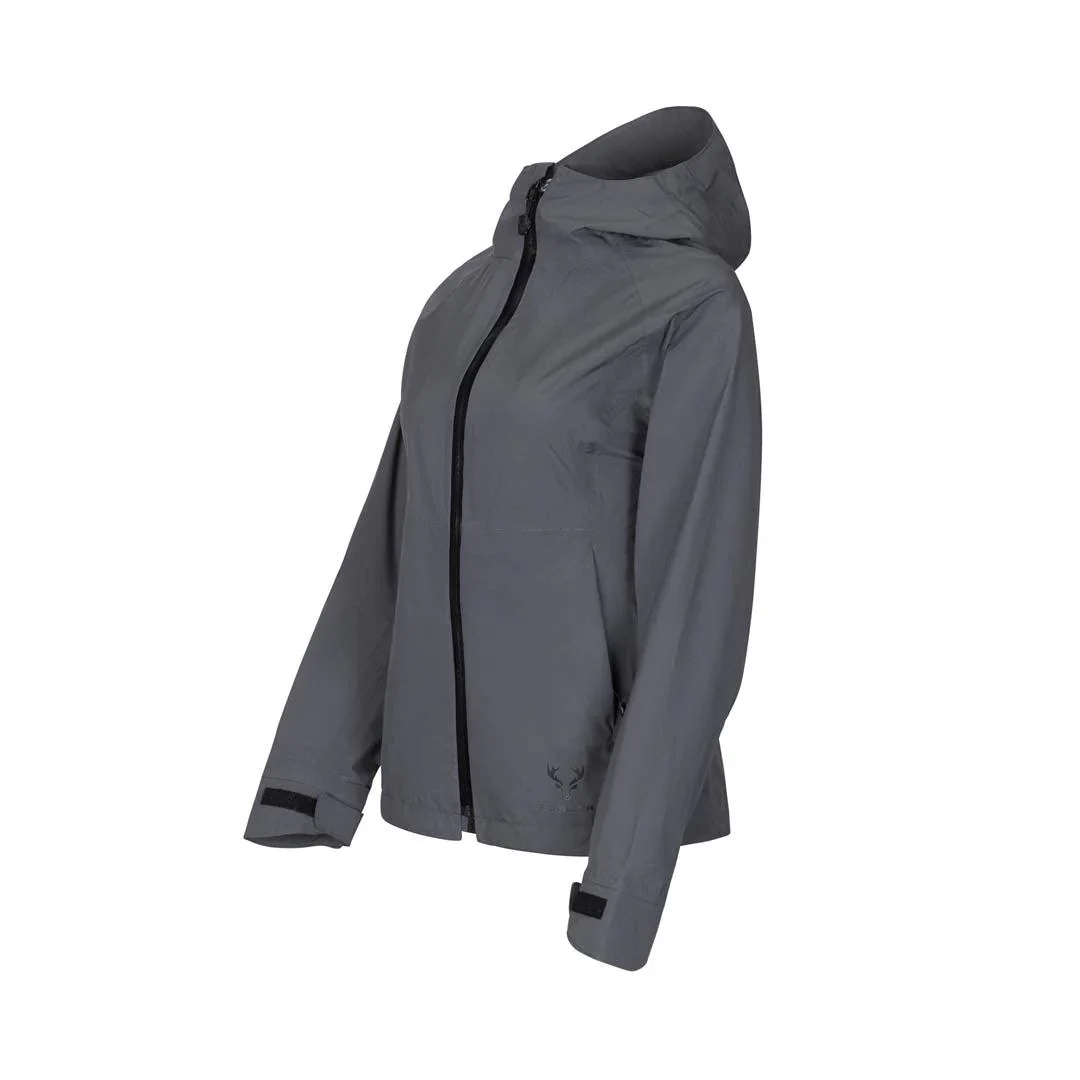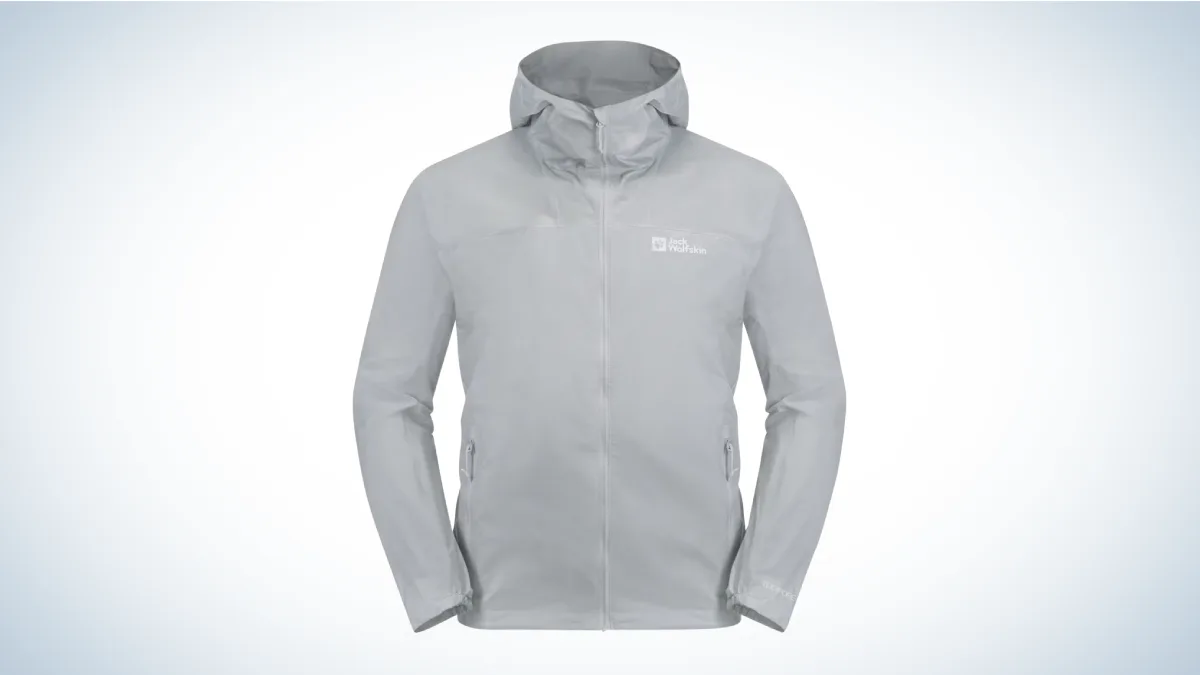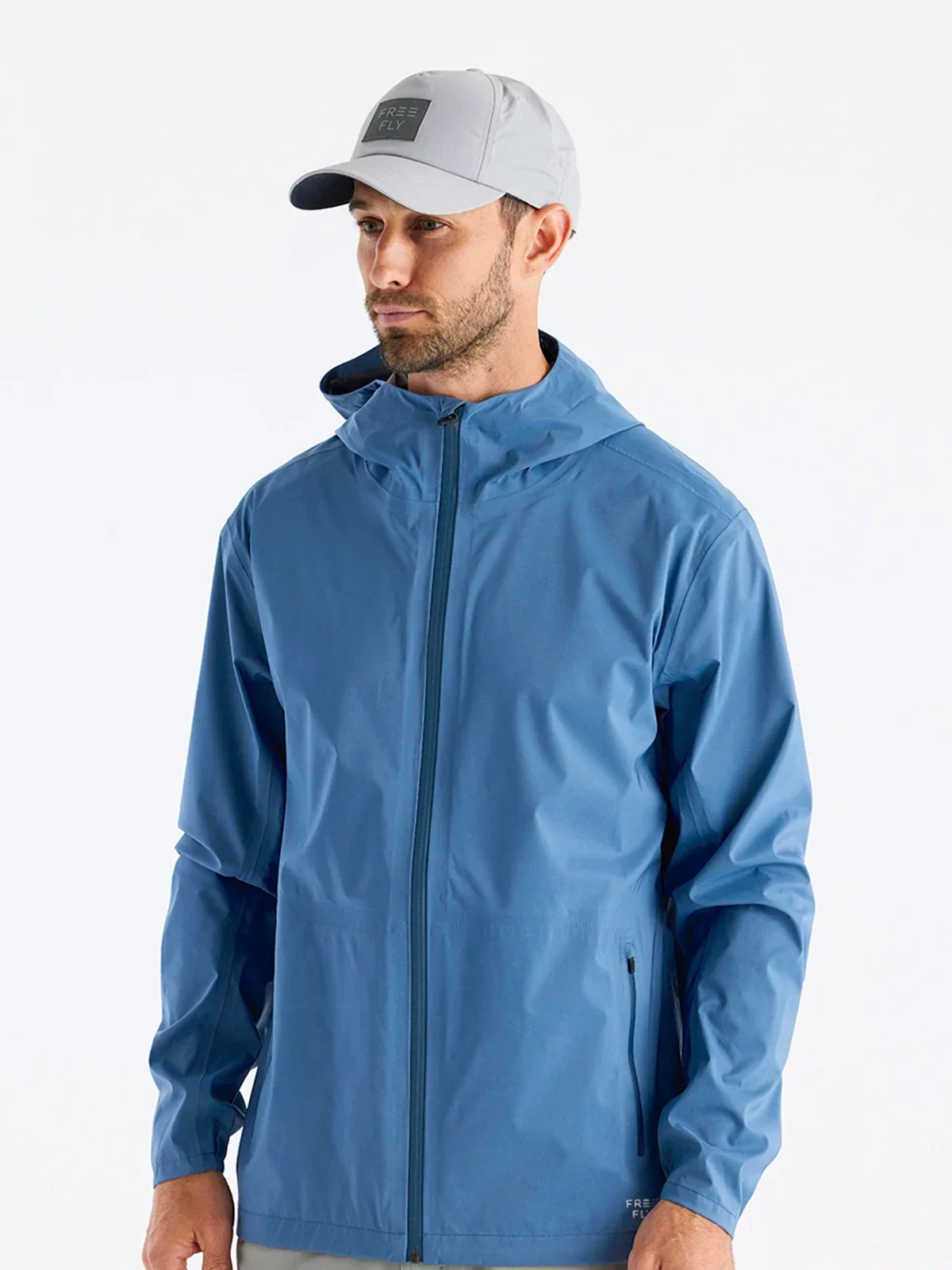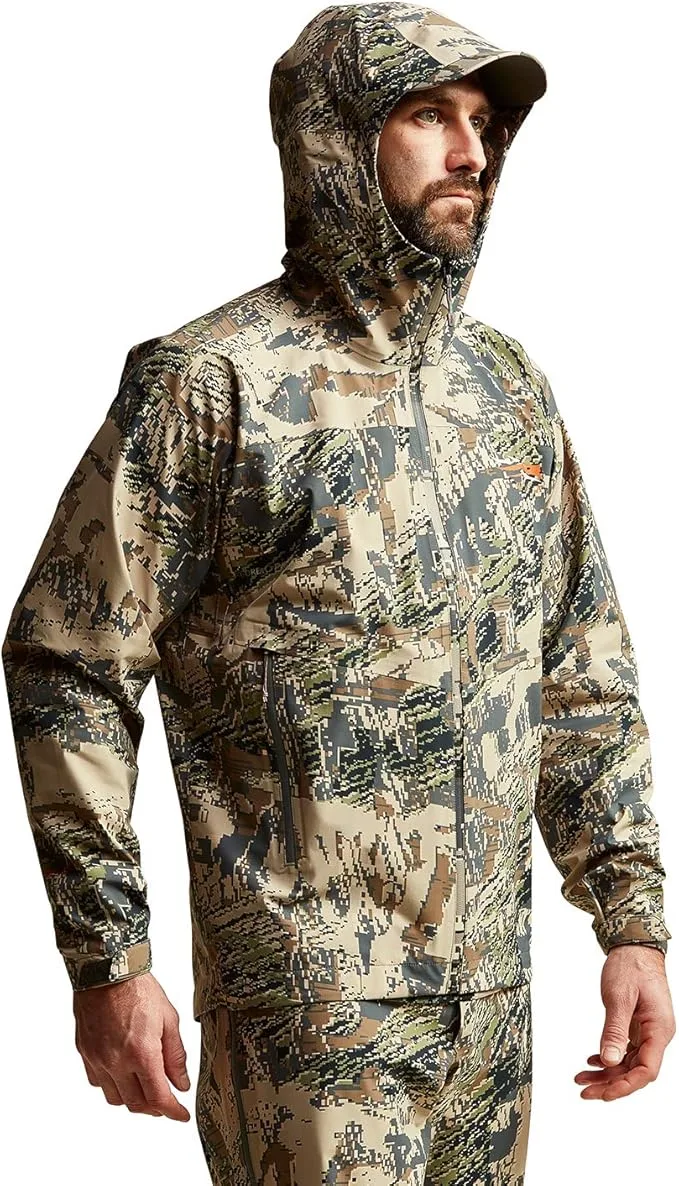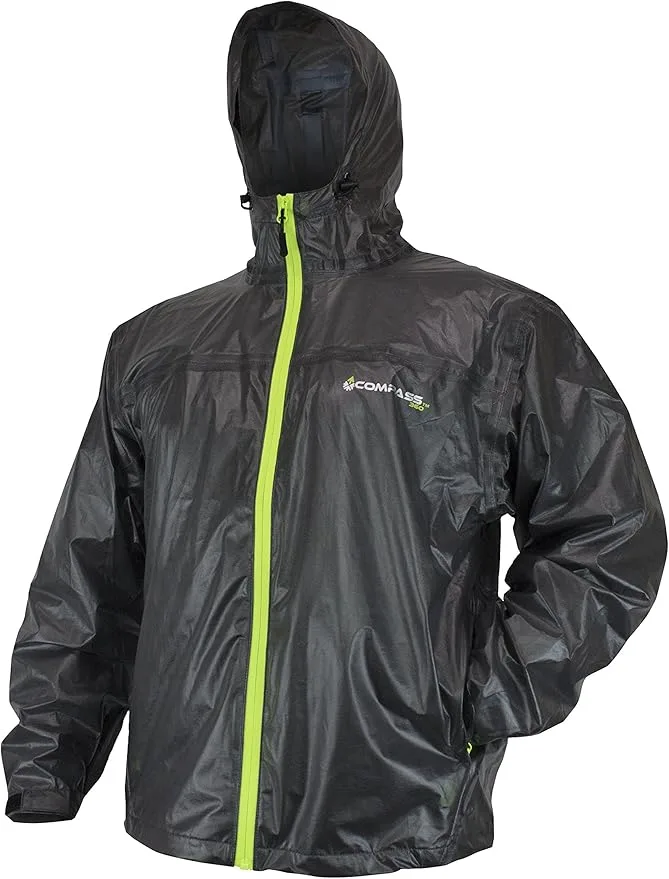We may earn revenue from the products available on this page and participate in affiliate programs. Learn more ›
A backpacking rain jacket is a must-have, even if you’re expecting nothing but bright, sunny hiking weather. Mother Nature is unpredictable; you never know when the sky might open up in a torrential downpour. However, you can’t just stuff any old rain jacket in your pack when you’re out in the backcountry. As the old hiker’s saying goes, “ounces equal pounds, and pounds equal pain.” On the trail, heavy gear leads to a lot of physical suffering. The trick is to find a quality lightweight rain jacket that will keep you dry when you need it but won’t weigh you down or hog precious pack space when you don’t.
I am no stranger to backpacking in lousy weather. Hiking in the rain is a great way to have the trails (mostly) to myself. I’ve braved precipitation from the Carolina coast to Colorado’s Flat Tops Wilderness. I’ve seen more than my fair share of raindrops, sometimes in the form of multiple days of slow, steady drizzle and sometimes surprising torrential downpours. In the process, I’ve developed some serious gratitude for quality rain gear.
We put some of the most popular rain gear brands to the test to find the best backpacking rain jackets to keep you dry on the trail.
The Best Backpacking Rain Jackets
Best Overall: Patagonia Torrentshell 3L
Best Lightweight: Frogg Toggs Ultra-Lite
Best Poncho: Sea to Summit Nylon Tarp Poncho
Best Women’s: Forloh Airalite
Best Men’s: Jack Wolfskin Prelight 2.5L
Best Ultralight: Montbell Versalite
Most Comfortable: Free Fly Cloudshield
Best for Hunting: Sitka Dew Point
Best Budget: Compass 360 Ultra-Pak
Best Overall: Patagonia Torrentshell 3L
Specs
Sizes: Men’s S-XXL; Women’s XS-XXL
Weight: 12.4 ounces
Material: 3-layer PFC-free shell with 50D ripstop recycled nylon face fabric
Waterproofing: DWR finish (20,000mm)
Pit Zips: Yes
Pros
Warm microfleece lining at neck
Handwarmer pockets
Self-stuffs into a zippered pocket for easy packing
Adjustable hood
Durable material
Cons
Crinkly exterior
The Patagonia Torrentshell is made from thick, tear-resistant 50D ripstop recycled nylon, so if you are rough on your backpacking gear, this jacket should probably find its way into your pack. One of the more durable rain jackets we tested, the Torrentshell performs well above its price point and should easily handle even seasons of brutal trail conditions.
Not only is this thing tough, it is built to keep out moisture. It uses Patagonia’s proprietary H2No Performance Standard technology, which specs out at 20,000mm waterproofness. The jacket performed flawlessly in our tests, keeping the tissue paper and the base layer dry as dust. The jacket also has a tricot backing for next-to-skin comfort and excellent moisture-wicking performance.

The Torrentshell’s zipper was my only concern. Most of the jackets on the test list have super-tight zippers that fasten so tightly that they look like they could keep out nuclear radiation. The Torrentshell’s zipper looks more like a standard jacket zip. However, Patagonia uses a three-fold storm flap set-up that encases the zipper, and the system did a fine job of keeping water on the outside of the jacket.
While this wasn’t the lightest jacket in the test group, the extra ounces aren’t a dealbreaker. It packs down easily by stuffing it into its left handwarmer pocket. The result is a compact package with a webbing clip-in loop so you can conveniently attach it to the outside of your backpack for easy access.
The Torrentshell is also pretty stylish and looks as much at home downtown as it does on a backcountry trail. It comes in a veritable rainbow of solid and two-toned colors, so it should be easy to find something for your style.
Best Lightweight: Frogg Toggs Ultra-Lite 2
Specs
Sizes: Men’s S-XXL; Women’s S-XXL
Weight: 5.5 ounces
Material: Polypropylene
Waterproofing: Dipore Gen 2 membrane
Pit Zips: No
Pros
Stuff sack included
The lightest jacket on this list
Adjustable hood
Affordable
Cons
Flimsy
Not very breathable
The Frogg Toggs Ultra-Lite 2 is a super simple rain jacket without all the fancy bells and whistles. It’s also so lightweight and affordable that it removes any excuse not to pack a rain jacket on your next backpacking adventure.
The Ultra-Lite 2 was the lightest rain jacket in our test group. It easily rolls down to about the size of a pair of socks and weighs less than your average hiking hosiery. It is a basic two-layer shell, which makes this jacket pretty flimsy. This one definitely isn’t made to last. In fact, you should avoid brushing against twigs or sharp rocks and trim your fingernails before slipping it on. However, as long as it doesn’t rip, it does a good job of keeping water out.
One note: It doesn’t earn high marks in breathability, so be prepared to sweat under this one with even moderate activity. You can also buy the Frogg Toggs Ultra-Lite 2 Rain Suit, which includes waterproof rain pants, should you want head-to-toe coverage.
Best Poncho: Sea to Summit Nylon Tarp Poncho
Specs
Sizes: One size fits most
Weight: 14 ounces
Material: Waterproof 70D nylon
Pit Zips: No
Pros
Doubles as a two-person tarp shelter
Wide brim, 3-panel hood
Can be worn over your pack
Cons
Heavy
Not suitable for windy conditions
Rain ponchos rarely get the respect they deserve. Although ponchos may seem simple or even primitive in their design, modern rain ponchos regularly outperform rain jackets in wet weather. Unlike jackets that have to factor in breathability in their choice of fabric, ponchos can be made of fully waterproof materials and still stay well-ventilated by the nature of the design. They also have fewer breakable parts or leak-prone seams.
Tipping the scales at 14 ounces, the Sea to Summit Nylon Tarp Poncho is a heavyweight. However, it can pull double duty as both rain gear and a quick set-up two-person shelter. It rolls up into a compact package with its own stuff sack so that it won’t hog too much pack space, and when you need it. It slips on over your pack to keep you and your gear comfortably dry.
Best Women’s: Forloh Airalite
Specs
Sizes: Men’s S-XXXL; Women’s XS-XL
Weight: 14.7 ounces
Material: Ripstop nylon
Waterproofing: Patented Airadigm Pulse Plasma (20,000mm waterproof rating)
Pit Zips: Yes
Pros
Welded seamless pockets keep water out
Bonded brim hood
RECCO technology makes you searchable to professional rescuers
Cons
Heavy
The American-made Forloh Airalite was the heaviest rain jacket in our test group, tipping the scale at well over 14 ounces. Although still well under a pound, it is a heavyweight in the world of super light packable jackets. However, it folds into an ultra-compact size and has a super-impressive water resistance rating.
Whatever points this jacket might lose for weight, it more than makes up for in high-performance features. This is top-shelf rain gear.
Forloh uses a patented Airadigm Pulse Plasma fabric treatment that coats each fiber of the jacket’s durable ripstop nylon. It works instantly to repel wind and water yet also releases body heat and sweat so you can stay comfortably dry no matter the outside weather or your activity level.

One of the coolest features of the Airalite is its integrated RECCO reflectors. These lightweight electronic transponders make you searchable to professional rescuers with RECCO directional radar emitters, making you much easier to find if your backpacking adventure takes a dangerous turn.
The jacket also has underarm ventilation, a zipper vent flap on the back, ultra-quiet hook-and-loop “wrist hood” cuffs, and an adjustable hood with a bonded brim. As a woman, I appreciated how well this jacket fit my body. It had just the tiniest bit of curve at the waist and enough room in the chest to accommodate multiple layers without being too baggy.
Best Men’s: Jack Wolfskin Prelight 2.5L
Specs
Sizes: Men’s S-XXL; Women’s XS-XL
Weight: 5.8 ounces
Material: Polyamide
Waterproofing: 2.5-layer Texapore Pro fabric (10.000mm rating)
Pit Zips: No
Pros
Made from recycled materials
Adjustable hem
Very breathable
Easy to pack
Cons
Hood is not adjustable
Not suitable for heavy rain
Jack Wolfskin earns some bonus points in my book for its dedication to creating quality, sustainable products using recycled materials. However, the jacket didn’t need any bonus points because it earned high scores during testing and in the field.
Water beads easily on the jacket’s Texapore Pro fabric. The material also maintains a comfortable level of breathability, which is a plus during the physical exertion of traversing rough terrain with a heavy pack. It also has a feather-lite, barely-there fit and packs down to the size of an apple. However, this jacket performs best in a light, steady drizzle.

Although it held up fairly well during the garden hose test, some water somehow made its way into one of the zipped pockets, which could mean death to a cellphone in a downpour. The tissue paper also ended up damp during the 12-hour tissue paper test. If you’re hiking during the monsoon season, you should be prepared to get wet.
Best Ultralight: Montbell Versalite
Specs
Sizes: Men’s S-XL; Women’s S-XL
Weight: 5.8 ounces
Material: 2-layer Gore-Tex Windstopper 10-denier Ballistic Airlight nylon ripstop with a DWR finish
Waterproofing: 30,000 mm
Pit Zips: Yes
Pros
Ultra-lightweight weather-resistant zippers
Pocket hem adjuster
3-way adjustable roll-up hood
Packs down small
Cons
Prone to damage
From the single-piece K-Mono cut design to the lightweight Aqua-Tect zippers, everything about the Montbell Versalite Jacket is engineered to reduce weight, making it an ideal option for minimalist backpacking. Montbell even uses Smart Sewing Technology to cut ounces by removing extra fabric at the seams. The result is one of the lightest, most packable rain jackets on the market today.
On a rainy trail, a crappily designed hood equals misery. Fortunately, Montbell’s designers hit it out of the park with this one. The hood is adjustable from three separate points for a detailed fit. Two drawstring cords at the hem and a hook-and-loop tab at the back allow you to adjust the height and depth of the hood so you don’t have to compromise your peripheral vision to cover your noggin.
Another reason to love the Monbell Versalite is its near-perfect balance of water resistance and breathability. Although the Gor-Tex Windstopper is marketed as a wind shell and not a waterproof membrane, the company slapped on a DWR finish and fully taped the jacket’s seams to create rain protection that more than keeps up with the competition. The 2-layer Gore-Tex fabric also breathes like an extra set of lungs when you have to hoof it up a steep grade.
This jacket was a top contender for the best overall backpacking rain jacket. Its feature-rich, lightweight design makes it easy to fall in love with. However, the face fabric is a bit on the flimsy side, leaving us concerned about how this one will withstand long-term abuse in rough conditions. The sizes run a little small, so order accordingly, especially if you plan to wear it during layering season.
Most Comfortable: Free Fly Cloudshield
Specs
Sizes: Men’s S-XXL; Women’s XS-XL
Weight: 9.3 ounces
Material: Recycled nylon and polyester
Waterproofing: DWR finish (16,000mm waterproof rating)
Pit Zips: No
Pros
Quiet design
Soft and comfortable
Doesn’t look like a rain jacket
Made with recycled materials
Cons
Expensive
Comfort is the first thing I noticed when I slipped on the Free Fly Cloudshield. The jacket’s soft tricot lining is super comfy, even when worn directly next to the skin, and the exterior is designed to be soft and quiet. It definitely doesn’t feel like a rain jacket. It was a buttery-soft breath of fresh air in a stiff, sticky, plastic-feeling rain gear lineup.
Because the Cloudshield doesn’t feel like rain gear, I initially questioned how this outer layer would stand up to water. However, it held up like a champ in testing, keeping the base layer bone dry. The tissue paper was just barely damp at the 12-hour mark.
It fits nicely under a pack and doesn’t give any of the “swish swish” sound that most rain gear makes when moving through the woods. It’s also cut with plenty of room for layering.

Free Fly also makes the Cloudshield from recycled materials, so I can feel good about making ecologically responsible choices while staying dry on the trail. If I have any complaints, it would have to be the price tag. But top-notch gear rarely comes cheap, and this jacket is definitely top-notch.
Best for Hunting: Sitka Dew Point Rain Jacket
Specs
Sizes: Men’s M-3XL
Weight: 12.5 ounces
Material: 20-denier fabric
Waterproofing: 3-layer GORE-TEX
Pit Zips: Yes
Pros
Adjustable hems and cuffs
Cut to accommodate added layers for cold-weather comfort
Accessible zippered pockets even when wearing a pack belt
Cons
Only available in men’s sizes
Although Sitka is best known for designing and manufacturing best-in-class hunting gear—including our favorite hunting jacket—it performs like a rockstar in the backcountry whether or not you’re toting a rifle. The Dew Point is Sitka’s lightest, most packable rain jacket, and we are here for it.
The Dew Point has features that backcountry hunters and backpackers alike will appreciate, including micro-taped seams, pit zips, and an adjustable drop-away hood. Sitka designed the Dew Point’s pockets so you can easily access a binocular harness or pack belt without having to strip out of your rain gear, which is an absolute game-changer when you are chasing big bulls in the backcountry.
It’s available in solid shades as well as several Optifade camo patterns. Unfortunately, however, it only comes in men’s sizes. If you’re a backcountry adventurer without a Y chromosome, you’ll have to make do, which could be hard for more petite hikers.
Best Budget: Compass 360 Ultra-Pak Rain Jacket
Specs
Sizes: Men’s S-XXL; Women’s S-XL
Weight: 7.5 ounces
Material: Polypropylene
Waterproofing: DWR-free waterproof fabric
Pit Zips: No
Pros
Stuffs into zippered self-storage pocket
3-way adjustable hood
Reflective piping
Affordable
Cons
Not breathable
Backpacking on a budget isn’t always easy. Quality gear can put a serious hurt on your wallet. Fortunately, there are some great budget-friendly options for backpacking rain gear.
The Compass Ultra-Pak rain jacket may be frugally priced, but it performs well above its price point. This feather-lite, packable jacket features taped seams, elastic cuffs, a drawstring cinch hem, and water-resistant zippers. It also has reflective piping across the back, which is a bonus if you’re hiking in groups or need enhanced visibility for search and rescue teams.
The Ultra-Pak is made from waterproof polypropylene, which isn’t particularly breathable. The jacket has a large vented section across the back, but it’s basically useless when you’re wearing a pack, so be prepared to get clammy underneath if you have to wear this one for more than an hour. It does, however, do an impressive job of keeping water out.
How We Tested the Best Backpacking Rain Jackets
After consulting online resources and chatting it up with brand reps, I hit the field and, for once, prayed for rain. I used the rain jackets on the trail (and enlisted some help from family and friends) and put them through a series of controlled tests to prove their mettle. Testing included a garden hose with a spray nozzle to see if an initial drenching would leak through to a base layer. I also left water to pool on jacket seams for 12 hours. I placed a piece of tissue paper under the seam to see if water would leak through when left to sit.

I weighed each jacket on a kitchen scale and rolled them burrito-style to analyze their packability. Since backpacking rain jackets spend most of their lives stuffed in a backpack, I wanted to make sure they wouldn’t take up too much precious pack space. I also hiked a mile in each rain jacket while carrying a pack to test breathability and mobility when worn under backpack straps and a waist belt.
Backpacking Rain Jacket Buying Guide
Waterproof Rating
Smart looks and fancy features don’t mean much if you end up wet under your rain gear. Understanding relative water resistance is the first step in choosing a rain jacket that will keep you dry.
Brands like to tout their patented waterproofing methods. However, looking at a jacket’s waterproof rating will ensure you compare apples to apples. Waterproofing is measured by the amount of water, in millimeters, that can sit on the fabric before seeping through. Material that gets an official “waterproof” rating must keep out at least 1,000 mm of water for 24 hours.
A 1,000 mm waterproof rating is generally acceptable for walking your dog in a drizzle. However, outdoor adventurers often encounter more severe weather, so serious backpackers should opt for gear with a waterproof rating between 5,000 mm and 30,000 mm.
Breathability
There is plenty of heavy-duty rain gear out there, including tough-as-nails rain jackets guaranteed to keep you bone dry from the outside in, even in monsoon conditions. Unfortunately, those jackets aren’t usually very breathable and can quickly drench you in sweat from the inside out while you are hiking.
Many companies use proprietary air-permeable waterproof membranes designed to help dispel body heat and keep the wearer well-ventilated during physical activity. Unfortunately, there’s usually a trade-off. More breathable fabrics tend to sacrifice water resistance.
Built-in ventilation like pit zips and back flaps can help keep air circulating so sweat doesn’t build up under your rain jacket.
Weight and Packed Size
Unless you’re hiking in wet climates, your rain gear will probably spend more time in your backpack than on your body. Backpacking rain jackets need to be as light and compact as possible while maintaining their ability to keep you dry. That’s why we only tested rain jackets that weighed less than a pound.
Comfort
Although staying dry goes a long way in keeping you happy in wet weather, it isn’t the only factor in comfort. A rain jacket should fit comfortably, especially when you’re wearing a backpack. It shouldn’t inhibit movement, the hood shouldn’t block your vision, and it shouldn’t feel sticky, even when it sits directly against your skin.
FAQs
Q: How much should a backpacking rain jacket weigh?
Usually, in the world of backpacking, lighter is better. However, flimsy rain jackets tend to perform poorly in the rain. If you can keep the weight of your rain jacket under 14 ounces, you’re back will certainly thank you. If you’re into ultralight backpacking, you’ll appreciate a rain jacket that weighs under 8 ounces to stick in your ultralight backpack.
Q: How do you pack a rain jacket in a backpack?
There are few things worse than discovering your rain jacket is at the bottom of your backpack just as the sky opens up. Pack your rain gear in the top zone of your pack so you can get to it quickly when the weather turns sour.
Q: What’s the difference between waterproof and water-resistant?
Waterproof material creates a barrier that keeps all water out. On the other hand, water-resistant material is so tightly woven that it is difficult but not impossible for water to get through. However, when it comes to rain jackets, there’s more to the waterproof/water-resistance issue. Although a plastic garbage bag is technically waterproof, it isn’t a great option for hiking in the rain because you would quickly overheat and end up drenched in sweat.
Many hiking rain jackets also feature a durable water repellant (DWR) coating that beads water on the surface so it drips off rather than soaking into the fabric.
Why Trust Us
For more than 125 years, Field & Stream has been providing readers with honest and authentic coverage of outdoor gear. Our writers and editors eat, sleep, and breathe the outdoors, and that passion comes through in our product reviews. You can count on F&S to keep you up to date on the best new gear. And when we write about a product—whether it’s a bass lure or a backpack—we cover the good and the bad, so you know exactly what to expect before you decide to make a purchase.

